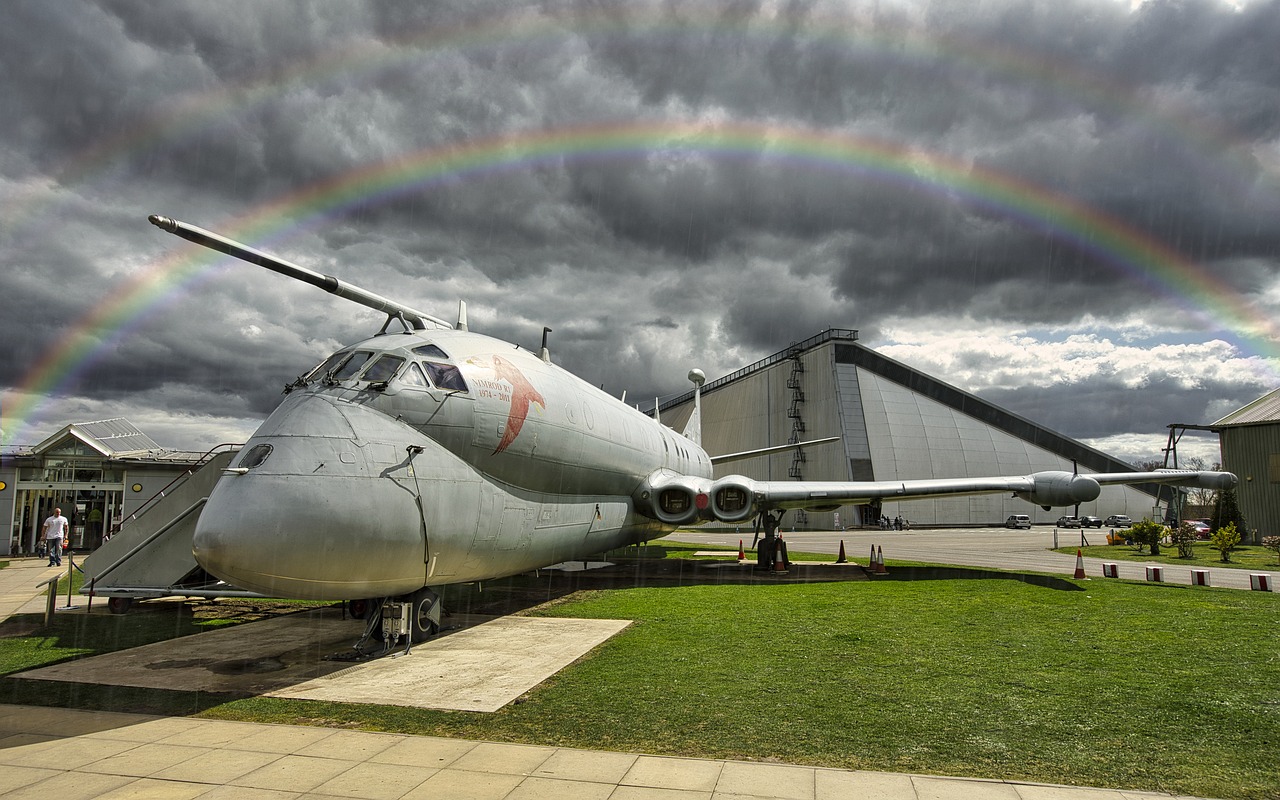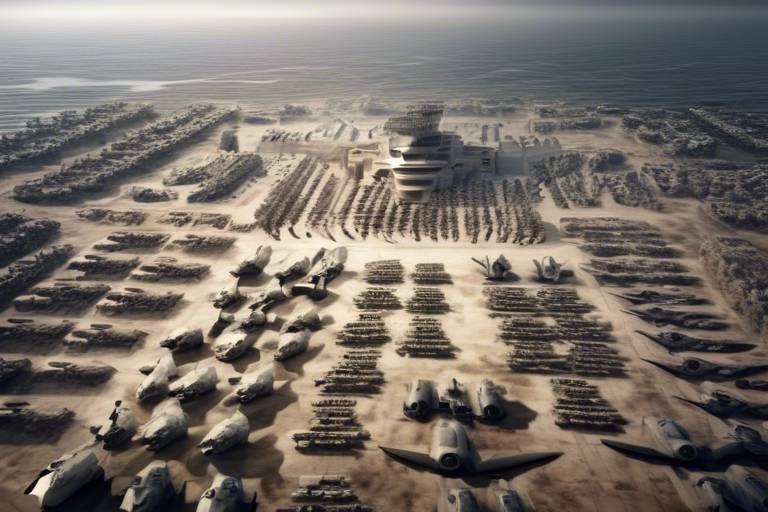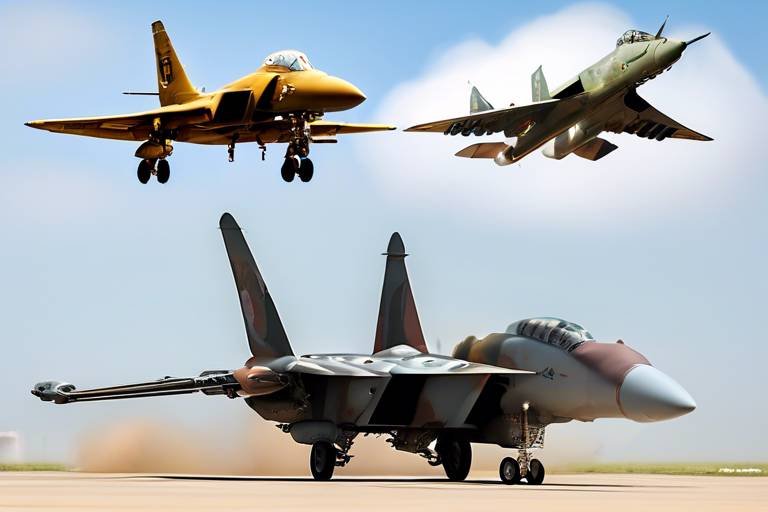How Advanced Defense Systems Address Global Security Threats
In an era where global security threats are more complex and multifaceted than ever before, advanced defense systems have emerged as a crucial component in safeguarding nations and maintaining international stability. These systems are not just about military might; they encompass a wide array of technologies and strategies designed to counter threats ranging from traditional warfare to cyber attacks. As we delve deeper into this topic, it's essential to understand how these systems have evolved over time, the integration of cutting-edge technologies like artificial intelligence, and the importance of international collaboration in addressing shared security challenges.
The history of defense technologies is a fascinating journey marked by innovation and adaptation. From the invention of the bow and arrow to the development of nuclear weapons, each era has brought forth advancements that significantly changed the landscape of warfare. In recent decades, we have witnessed a rapid evolution in defense technologies driven by the need to respond to emerging threats. For instance, the rise of unmanned aerial vehicles (UAVs), commonly known as drones, has revolutionized surveillance and combat operations. These technologies allow for precision strikes without risking human lives on the battlefield.
Moreover, the integration of satellite technology has enhanced communication and intelligence-gathering capabilities, enabling military forces to operate more effectively across the globe. The development of missile defense systems, such as the Terminal High Altitude Area Defense (THAAD), illustrates the shift towards proactive measures in countering ballistic missile threats. As we look to the future, the continuous advancement of defense technologies will undoubtedly play a pivotal role in shaping global security strategies.
As we transition into the digital age, the importance of cybersecurity within advanced defense systems cannot be overstated. Protecting critical infrastructure and sensitive data from cyber threats is now a priority for nations worldwide. Cybersecurity measures are designed to shield military networks, communication systems, and operational data from malicious attacks that could cripple national defense capabilities.
Robust cyber defense strategies are essential for safeguarding national security. In a world where information can be weaponized, the potential consequences of a cyber breach could be catastrophic. Imagine a scenario where an adversary gains access to military plans or communications; the implications could destabilize entire regions. Therefore, investing in advanced cybersecurity protocols is not just a technical requirement; it's a matter of national survival.
The landscape of cyber threats is constantly evolving, with new challenges emerging regularly. Some of the most pressing threats include:
- Ransomware: Malicious software designed to block access to a system until a ransom is paid.
- State-sponsored hacking: Cyber operations conducted by nation-states to achieve political or military objectives.
- Phishing attacks: Attempts to acquire sensitive information by masquerading as a trustworthy entity in electronic communications.
These threats not only target military systems but also critical infrastructure such as power grids and financial institutions, underscoring the need for comprehensive cybersecurity measures.
To counteract these growing cyber threats, defense systems can implement a variety of effective mitigation strategies, including:
- Regular security audits: Conducting assessments to identify vulnerabilities in systems.
- Employee training: Educating personnel about cyber hygiene and recognizing potential threats.
- Incident response plans: Developing protocols to swiftly address and mitigate the impact of cyber incidents.
By adopting these strategies, nations can enhance their resilience against cyber attacks and ensure the integrity of their defense operations.
The integration of artificial intelligence (AI) into defense systems is revolutionizing how military operations are conducted. AI enhances decision-making processes, allowing for quicker and more accurate responses to threats. For example, AI algorithms can analyze vast amounts of data in real-time, providing military leaders with actionable insights that were previously unattainable. This capability not only improves threat detection but also optimizes resource allocation, making defense operations more efficient.
In today's interconnected world, no nation can tackle security threats in isolation. International collaboration is vital for developing and deploying advanced defense systems. By working together, countries can share knowledge, resources, and best practices, ultimately strengthening their collective defense capabilities.
Joint military exercises play a crucial role in fostering cooperation among nations. These exercises allow military forces from different countries to train together, enhancing interoperability and understanding of each other's tactics and strategies. Such collaboration not only builds trust but also prepares nations to respond effectively to global threats.
Information sharing agreements among nations are another essential component of international defense collaboration. By exchanging intelligence and data, countries can improve their responses to emerging security threats. This collective approach allows for a more comprehensive understanding of potential risks and enables nations to act swiftly and decisively in times of crisis.
Q: What are advanced defense systems?
A: Advanced defense systems refer to modern technologies and strategies employed by nations to protect against various security threats, including military and cyber threats.
Q: How does AI enhance defense capabilities?
A: AI enhances defense capabilities by improving decision-making, threat detection, and operational efficiency through real-time data analysis.
Q: Why is international collaboration important in defense?
A: International collaboration is crucial because security threats are global in nature, and collective efforts improve responses and enhance overall security.

The Evolution of Defense Technologies
The world of defense technologies has undergone a remarkable transformation over the decades. From rudimentary weapons to sophisticated systems that integrate cutting-edge technology, the evolution has been driven by the need to address increasingly complex global security threats. In the early days, defense relied heavily on physical strength and basic weaponry, but as the geopolitical landscape shifted, so did the methods of warfare. Today, we find ourselves in an era where technology not only enhances military capabilities but also redefines them.
One of the most significant milestones in this evolution was the advent of nuclear weapons during World War II. The introduction of atomic bombs altered the course of history and introduced a new paradigm of deterrence. Countries realized that possessing such weapons could prevent conflicts through sheer intimidation. However, this also led to a dangerous arms race, prompting nations to invest heavily in research and development to maintain a competitive edge.
As we moved into the late 20th century, the focus shifted towards precision warfare. The Gulf War in the early 1990s showcased the effectiveness of advanced technologies like GPS-guided munitions and stealth aircraft. These innovations allowed for targeted strikes with minimal collateral damage, fundamentally changing military strategy. The ability to engage in warfare with pinpoint accuracy not only increased operational efficiency but also raised ethical questions about the implications of such power.
Fast forward to the 21st century, and we now find ourselves in a digital battleground. The rise of the internet and digital technologies has given birth to a new domain of warfare: cyber warfare. Nations are investing in cyber capabilities to protect their critical infrastructure and disrupt potential adversaries. The integration of artificial intelligence (AI) into defense systems is another game-changer, enabling faster decision-making and enhanced threat detection. These advancements are not just about having the latest gadgets; they represent a fundamental shift in how nations approach security.
Moreover, the evolution of defense technologies is not just a story of innovation; it is also about collaboration. Countries are increasingly recognizing that no single nation can tackle global security threats alone. International partnerships and alliances have become essential in developing and deploying advanced defense systems. This collaboration fosters the sharing of knowledge, resources, and strategies, ultimately enhancing collective security.
In summary, the evolution of defense technologies reflects a dynamic interplay between innovation, strategy, and collaboration. As we continue to face new and unpredictable threats, the development of advanced defense systems will remain a critical aspect of ensuring global peace and stability. The journey from traditional warfare to a technology-driven landscape has been nothing short of extraordinary, and it sets the stage for future advancements that will shape the security environment for generations to come.

Cybersecurity Measures in Defense
In today’s interconnected world, the significance of cybersecurity measures in defense cannot be overstated. As nations increasingly rely on technology to bolster their military capabilities, the potential for cyber threats to compromise national security has escalated dramatically. Advanced defense systems are now designed with comprehensive cybersecurity protocols that shield critical infrastructure and sensitive data from malicious attacks. Imagine a fortress not just built of stone, but fortified with an invisible shield that repels digital invaders. That’s the reality of modern defense strategies.
These cybersecurity measures encompass a broad spectrum of technologies and strategies aimed at ensuring the integrity, confidentiality, and availability of information. For instance, intrusion detection systems (IDS) play a crucial role in identifying and responding to unauthorized access attempts, while encryption technologies secure data transmission, making it unreadable to anyone who doesn’t have the proper keys. Moreover, firewalls serve as the first line of defense, filtering out harmful traffic and preventing data breaches before they can occur.
One of the most pressing concerns in the realm of cybersecurity is the constant evolution of threats. Cyber adversaries are becoming increasingly sophisticated, employing tactics that can bypass traditional security measures. This necessitates a proactive approach where defense systems not only react to threats but also anticipate them. This is where artificial intelligence comes into play, enabling systems to learn from past attacks and adapt in real-time. By analyzing patterns and behaviors in network traffic, AI can identify anomalies that may indicate a breach, allowing for swift action to be taken.
Furthermore, the importance of training and awareness among personnel cannot be overlooked. Even the most advanced technology can falter if the people operating it are not adequately prepared. Regular training sessions and simulations help ensure that military personnel are aware of the latest cyber threats and know how to respond effectively. This human element is crucial, as many breaches occur due to human error, whether it’s clicking on a malicious link or failing to update software.
To illustrate the multifaceted approach to cybersecurity in defense, consider the following table that highlights key components:
| Cybersecurity Measure | Description |
|---|---|
| Intrusion Detection Systems (IDS) | Monitors network traffic for suspicious activity and alerts administrators. |
| Encryption | Secures data by converting it into a code to prevent unauthorized access. |
| Firewalls | Acts as a barrier between trusted and untrusted networks, filtering traffic. |
| Artificial Intelligence | Enhances threat detection and response through pattern recognition and learning. |
| Personnel Training | Educates military staff on recognizing and responding to cyber threats. |
In conclusion, the integration of robust cybersecurity measures in defense systems is essential for safeguarding national security in the digital age. As threats continue to evolve, so too must the strategies employed to counteract them. By combining advanced technologies with comprehensive training and awareness, nations can build resilient defense systems capable of withstanding the challenges of modern warfare.
- What are the main components of cybersecurity measures in defense?
The main components include intrusion detection systems, encryption, firewalls, artificial intelligence, and personnel training.
- Why is personnel training important in cybersecurity?
Personnel training is crucial because human error is a significant factor in many cyber breaches. Well-trained personnel can recognize and respond to threats effectively.
- How does artificial intelligence enhance cybersecurity?
Artificial intelligence enhances cybersecurity by analyzing patterns in network traffic to identify anomalies that could indicate a breach, allowing for quicker responses.

Importance of Cyber Defense
In today's interconnected world, the significance of cyber defense cannot be overstated. As nations increasingly rely on digital infrastructure for their operations, the potential risks associated with cyber threats have escalated dramatically. Just like a castle needs strong walls to protect its inhabitants from invaders, countries must fortify their cyber domains to safeguard sensitive information and critical systems from malicious actors. But what exactly makes cyber defense so crucial? Let’s delve deeper.
First and foremost, robust cyber defense strategies are essential for maintaining national security. In an era where information can be weaponized, the stakes are incredibly high. A successful cyber attack can lead to the theft of classified data, disruption of essential services, and even compromise military operations. For instance, state-sponsored hacking incidents have shown us that adversaries can infiltrate government networks, stealing sensitive information that could be used to undermine a nation's stability. Thus, investing in cyber defense is akin to investing in a nation's future.
Moreover, the implications of cyber breaches extend beyond just national security; they can have profound economic consequences as well. Companies and governments alike have fallen victim to ransomware attacks, where hackers lock critical data and demand a ransom for its release. According to a recent report, the global cost of cybercrime is projected to reach $10.5 trillion annually by 2025. This staggering figure underscores the need for effective cyber defense mechanisms. By implementing strong cybersecurity protocols, organizations can not only protect their assets but also foster trust among their clients and citizens, which is vital for economic stability.
Additionally, the evolving landscape of cyber threats demands a proactive approach to defense. With the rise of sophisticated techniques used by cybercriminals, including artificial intelligence-driven attacks, it is imperative for defense systems to adapt and evolve. This means not just reacting to threats as they arise but anticipating potential vulnerabilities and addressing them before they can be exploited. For example, organizations can employ threat intelligence to stay one step ahead, analyzing patterns and behaviors to predict and mitigate potential attacks.
In conclusion, the importance of cyber defense in today's digital age cannot be ignored. It serves as the backbone of national security, economic stability, and the protection of sensitive information. As we continue to navigate the complexities of the cyber landscape, it is essential for nations and organizations to prioritize their cyber defense strategies. After all, in the realm of cybersecurity, being prepared is not just an option—it's a necessity.
- What are the main components of a robust cyber defense strategy? A robust cyber defense strategy typically includes threat intelligence, incident response planning, employee training, and regular security assessments.
- How can organizations improve their cyber defense? Organizations can improve their cyber defense by adopting advanced technologies, conducting regular training for employees, and implementing strict data access controls.
- Why is international cooperation important in cyber defense? International cooperation is crucial because cyber threats often transcend borders, and collaborative efforts can enhance overall security and response capabilities.

Emerging Cyber Threats
In today's digital landscape, the evolution of technology has brought about unprecedented advancements, but it has also opened the floodgates to a myriad of that pose significant risks to global security. As we navigate through this complex web of interconnected systems, it becomes increasingly clear that the battlefield has shifted from traditional warfare to the virtual realm. Cybercriminals and state-sponsored hackers are now wielding sophisticated tools to exploit vulnerabilities in critical infrastructure, corporate networks, and even individual devices.
One of the most alarming trends is the rise of ransomware attacks, where malicious actors encrypt sensitive data and demand hefty ransoms for its release. These attacks not only cripple organizations but also threaten national security, as essential services like healthcare and utilities become targets. For instance, the infamous Colonial Pipeline attack in 2021 demonstrated how a single cyber incident could disrupt fuel supplies across the Eastern United States, revealing the fragility of our infrastructure.
Moreover, we are witnessing an increase in state-sponsored hacking, where nations engage in cyber espionage to gather intelligence, disrupt operations, or undermine adversaries. These activities often blur the lines between warfare and cybercrime, complicating international relations and escalating tensions. Countries like Russia, China, and North Korea have been implicated in various high-profile breaches, targeting everything from government databases to major corporations. The implications of such actions are profound, as they can lead to diplomatic fallout and even military confrontations.
Additionally, the emergence of Internet of Things (IoT) devices has created a new frontier for cyber threats. With billions of connected devices, from smart home gadgets to industrial sensors, the attack surface has expanded exponentially. Many of these devices lack adequate security measures, making them easy prey for attackers. Imagine a scenario where hackers gain control over a city's traffic management system or a power grid; the potential chaos is staggering.
To combat these threats, organizations must adopt a proactive stance, continuously evolving their cybersecurity measures. This involves not only investing in advanced technologies but also fostering a culture of security awareness among employees. Training programs that educate staff about recognizing phishing attempts and suspicious activities can significantly reduce the likelihood of successful attacks.
In summary, as we delve deeper into the digital age, the landscape of cyber threats will continue to evolve. Staying ahead of these challenges requires vigilance, innovation, and collaboration among nations, organizations, and individuals. The stakes are high, and the consequences of inaction could be catastrophic. By understanding and addressing these emerging threats, we can better safeguard our digital future.

Mitigation Strategies
As the digital landscape continues to evolve, the threat of cyber attacks looms larger than ever. To effectively combat these threats, advanced defense systems must adopt a multifaceted approach to mitigation strategies. One of the first lines of defense is the implementation of comprehensive security protocols that encompass everything from firewalls to intrusion detection systems. These protocols serve as a safety net, ensuring that any unauthorized access attempts are swiftly identified and neutralized.
Moreover, continuous security training for personnel is crucial. In many cases, human error is the weakest link in the security chain. By conducting regular training sessions and simulations, organizations can significantly reduce the risk of breaches caused by negligence. This training should include recognizing phishing attempts, understanding the importance of strong passwords, and knowing how to respond to suspicious activities.
Another key strategy involves the use of advanced analytics and machine learning algorithms. These technologies can analyze vast amounts of data in real-time to identify patterns that may indicate a potential threat. By leveraging these tools, defense systems can not only respond to incidents more quickly but also anticipate and mitigate threats before they escalate. For example, predictive analytics can help identify vulnerabilities in the system, allowing for timely updates and patches.
Additionally, establishing a robust incident response plan is essential. This plan should detail the steps to be taken in the event of a cyber attack, including communication protocols, roles and responsibilities, and recovery procedures. A well-defined incident response plan ensures that all team members know their responsibilities and can act swiftly, minimizing damage and downtime.
Furthermore, fostering a culture of collaboration and information sharing among organizations can significantly enhance mitigation efforts. By sharing threat intelligence, organizations can stay informed about the latest cyber threats and vulnerabilities. This collaborative approach not only strengthens individual defenses but also contributes to a more resilient overall security posture within the industry.
In summary, the integration of security protocols, continuous training, advanced analytics, incident response planning, and collaborative efforts form a comprehensive strategy to mitigate cyber threats. As we navigate an increasingly complex digital environment, these strategies will be vital in ensuring the integrity and security of critical infrastructures worldwide.
- What are the most common types of cyber threats?
Common types include ransomware, phishing, malware, and state-sponsored hacking. - How can organizations improve their cyber defense?
Organizations can enhance their defenses by implementing security protocols, conducting regular training, and utilizing advanced analytics. - What role does employee training play in cybersecurity?
Training helps employees recognize potential threats and reduces the risk of human error, which is often a significant factor in breaches. - Why is information sharing important in cybersecurity?
Information sharing allows organizations to stay updated on emerging threats, enhancing collective security measures.

Integration of AI in Defense Systems
In today's rapidly evolving security landscape, the integration of artificial intelligence (AI) into defense systems has emerged as a game-changer. Imagine a world where machines not only assist but also enhance decision-making processes, providing military leaders with unprecedented insights and capabilities. AI technologies are revolutionizing how defense forces operate, enabling them to respond to threats with speed and precision that was once unimaginable. From autonomous drones to predictive analytics, AI is fundamentally reshaping the battlefield.
One of the most significant advantages of AI in defense is its ability to process vast amounts of data in real-time. In a typical military operation, the amount of information generated can be overwhelming. AI algorithms can sift through this data, identifying patterns and anomalies that human analysts might miss. This capability not only enhances threat detection but also allows for more informed decision-making. For instance, AI can analyze satellite imagery to spot unusual troop movements or monitor communication channels for signs of impending attacks.
Moreover, AI-driven systems can improve operational efficiency. Consider the logistics involved in military operations: supply chains, personnel deployment, and resource allocation can be complex and prone to human error. AI can optimize these processes by predicting needs based on historical data and current conditions. This predictive capability ensures that troops have the resources they need exactly when and where they need them, significantly boosting operational readiness.
However, the integration of AI in defense is not without its challenges. Ethical considerations arise, particularly concerning the use of autonomous weapons systems. Questions about accountability, decision-making in life-and-death situations, and the potential for unintended consequences are critical discussions that need to be addressed. As we move forward, it’s essential to establish robust frameworks that govern the use of AI in military contexts, ensuring that technology serves humanity rather than undermines it.
In addition to operational improvements, AI also plays a crucial role in enhancing cybersecurity measures within defense systems. With cyber threats on the rise, AI can help identify vulnerabilities and respond to attacks in real-time. By analyzing network traffic and user behavior, AI systems can detect anomalies that may indicate a cyber intrusion, allowing for rapid response and mitigation. This proactive approach is vital in safeguarding national security and protecting sensitive information.
To illustrate the impact of AI in defense, consider the following table that outlines key applications of AI technologies:
| Application | Description |
|---|---|
| Autonomous Drones | Unmanned aerial vehicles that can conduct surveillance and strike missions with minimal human intervention. |
| Predictive Analytics | Using historical data to forecast potential threats and optimize resource allocation. |
| Cyber Defense | AI systems that monitor networks for suspicious activity and respond to cyber threats in real-time. |
| Logistics Optimization | AI algorithms that streamline supply chain management and troop deployment. |
As we look to the future, the potential for AI in defense systems is vast. Continued investment in research and development will be crucial to unlocking new capabilities and addressing the challenges that come with them. By embracing AI, defense forces can not only enhance their operational effectiveness but also ensure a more secure global environment.
- What are the main benefits of integrating AI in defense systems? AI enhances decision-making, improves operational efficiency, and strengthens cybersecurity measures.
- Are there ethical concerns regarding AI in military applications? Yes, issues such as accountability and the use of autonomous weapons raise significant ethical questions.
- How does AI improve threat detection? AI can analyze large datasets quickly, identifying patterns and anomalies that indicate potential threats.
- What role does AI play in logistics? AI optimizes supply chains and resource allocation, ensuring troops have what they need when they need it.

International Collaboration in Defense
In an increasingly interconnected world, the concept of defense has evolved beyond the traditional boundaries of national security. International collaboration in defense is not just beneficial; it’s essential. As global threats become more complex and multifaceted, nations are finding that working together enhances their ability to respond effectively. Think of it like a team sport; when each player brings their unique skills to the field, the team as a whole performs better. This cooperation manifests in various forms, from joint military exercises to shared intelligence, creating a robust framework for addressing security challenges.
One of the most significant aspects of international collaboration is the establishment of defense alliances. Organizations like NATO (North Atlantic Treaty Organization) exemplify how countries can unite under a common goal of mutual defense. These alliances not only deter potential aggressors but also provide a platform for sharing resources and expertise. For instance, during joint military exercises, member nations can test their strategies and technologies in real-time, thereby strengthening their operational capabilities. The synergy created through these exercises fosters trust and enhances communication, which are vital during crises.
Moreover, information sharing agreements play a pivotal role in international defense collaboration. By pooling intelligence, nations can gain a clearer picture of potential threats, making it easier to formulate effective responses. For example, countries often share data on emerging cyber threats, allowing them to develop countermeasures more swiftly. This collaborative approach is akin to a neighborhood watch program; when everyone is vigilant and shares information, the entire community is safer. The table below illustrates some key benefits of these information-sharing initiatives:
| Benefit | Description |
|---|---|
| Enhanced Threat Detection | Collaborative intelligence leads to quicker identification of threats. |
| Resource Optimization | Shared resources reduce costs and improve efficiency. |
| Strengthened Alliances | Increased trust through transparency and cooperation. |
| Rapid Response | Joint strategies allow for quicker action during crises. |
As we delve deeper into the implications of international defense collaboration, it’s essential to recognize the challenges that come with it. Different nations often have varying political agendas, military capabilities, and cultural perspectives. These differences can lead to misunderstandings or conflicts of interest. However, overcoming these challenges is crucial for maintaining global peace and stability. Just like in any relationship, effective communication and mutual respect are key to ensuring that all parties work toward a common goal.
In conclusion, the importance of international collaboration in defense cannot be overstated. As the landscape of global security continues to evolve, the need for nations to unite in their efforts becomes even more pressing. By sharing information, conducting joint exercises, and fostering alliances, countries can not only enhance their own defense capabilities but also contribute to a more secure world. After all, in the face of shared threats, collaboration is not just an option; it’s a necessity.
- Why is international collaboration in defense important? It enhances the ability to respond to complex global threats and fosters trust among nations.
- What are some examples of international defense alliances? NATO and the United Nations Peacekeeping Forces are prominent examples.
- How do joint military exercises benefit participating nations? They improve operational capabilities, enhance communication, and build trust among allied forces.
- What challenges do nations face in collaborating on defense? Differences in political agendas, military capabilities, and cultural perspectives can create obstacles.

Joint Military Exercises
Joint military exercises are more than just a display of military might; they are a crucial element in the fabric of international defense cooperation. These exercises serve as a platform for nations to come together, share knowledge, and enhance their collective capabilities in responding to global threats. Imagine a group of chefs from different countries coming together to create a culinary masterpiece; each brings their unique flavor and technique, resulting in a dish that is far superior to what any one chef could create alone. Similarly, joint military exercises allow countries to blend their strengths, improving interoperability and fostering trust among allies.
Through these collaborative efforts, participating nations can simulate real-world scenarios, ranging from humanitarian missions to combat operations. For instance, during the recent Operation Pacific Shield, forces from the United States, Japan, and Australia conducted joint exercises aimed at enhancing disaster response capabilities. This not only improved their readiness for actual crises but also solidified their strategic partnerships in the Asia-Pacific region. The benefits of such exercises extend beyond the immediate tactical advantages; they also lay the groundwork for long-term relationships that can be pivotal during times of conflict.
Moreover, joint military exercises often involve extensive planning and coordination, which can be as intricate as a well-orchestrated ballet. They require clear communication, mutual respect, and an understanding of each nation's military doctrine. This level of cooperation can lead to the establishment of Information Sharing Agreements, where nations agree to share intelligence and resources, further enhancing their defense strategies. The following table summarizes some key benefits of joint military exercises:
| Benefits | Description |
|---|---|
| Enhanced Interoperability | Improves coordination and effectiveness of joint operations. |
| Increased Trust | Builds relationships and trust among allied nations. |
| Realistic Training | Offers practical experience in simulated combat scenarios. |
| Resource Sharing | Facilitates the sharing of technology and intelligence. |
In addition to enhancing military readiness, joint exercises also provide a platform for cultural exchange and understanding among service members. When soldiers from diverse backgrounds train together, they learn not only about each other's military tactics but also about their cultures, values, and perspectives. This fosters a sense of camaraderie and unity that is essential in times of crisis.
As global security threats continue to evolve, the importance of joint military exercises cannot be overstated. They serve as a vital mechanism for nations to prepare for the unforeseen, ensuring that when the time comes to act, they do so as a cohesive and effective unit. In a world where threats can arise suddenly and unexpectedly, being prepared through collaboration is not just advantageous; it is essential.
- What are joint military exercises? Joint military exercises are collaborative training sessions conducted by two or more nations to enhance their military capabilities and cooperation.
- Why are joint military exercises important? They improve interoperability, build trust among allies, and prepare forces for real-world scenarios.
- How often do these exercises occur? The frequency varies by region and political climate, but many nations engage in joint exercises annually or biannually.
- Can joint military exercises prevent conflicts? While they cannot prevent conflicts outright, they can enhance preparedness and foster diplomatic relationships that may help de-escalate tensions.

Information Sharing Agreements
In today's interconnected world, the significance of (ISAs) cannot be overstated. These agreements serve as vital frameworks that enable countries to exchange critical information regarding security threats, intelligence, and operational strategies. Imagine a team of detectives sharing clues to solve a complex case; that’s precisely what ISAs facilitate on a global scale. By pooling resources and knowledge, nations can enhance their ability to respond to threats that transcend borders, creating a more robust defense posture.
One of the key benefits of ISAs is the ability to enhance situational awareness. When countries share intelligence about potential threats, they can better understand the global security landscape. This collaborative approach allows for a more comprehensive assessment of risks, leading to timely and effective responses. For instance, if one nation identifies a rising terrorist threat, sharing this information with allies can lead to preemptive actions that thwart potential attacks.
Moreover, ISAs promote trust and cooperation among nations. When countries engage in formal agreements to share information, they signal a commitment to collective security. This trust is crucial, especially in times of heightened tensions. For example, during a crisis, nations can rely on their established ISAs to quickly disseminate information that could prevent misunderstandings or escalations. In this sense, ISAs are not just about sharing data; they are about fostering relationships built on mutual respect and shared goals.
However, while the benefits of ISAs are clear, there are also challenges to consider. Issues such as data privacy, national sovereignty, and the potential for misuse of shared information can complicate these agreements. Countries must navigate these challenges carefully to ensure that the information shared is used responsibly and ethically. For instance, establishing clear guidelines on what information can be shared and how it will be used is essential to maintaining trust among partners.
To illustrate the impact of ISAs, consider the following table that outlines key elements of successful information sharing:
| Element | Description |
|---|---|
| Clarity | Clear definitions of what information will be shared and the purpose behind it. |
| Trust | Building and maintaining trust between nations is crucial for effective collaboration. |
| Responsibility | Ensuring all parties understand their responsibilities regarding the use of shared information. |
| Timeliness | Information must be shared promptly to be actionable in crisis situations. |
As we move forward, the evolution of technology will further enhance the capabilities of ISAs. Advanced data-sharing platforms, artificial intelligence, and real-time communication tools will facilitate even more effective collaboration. Countries that embrace these innovations will likely find themselves better equipped to tackle emerging security threats. In essence, ISAs are not just agreements; they are essential components of modern defense strategies, ensuring nations can stand united against common challenges.
- What are Information Sharing Agreements? ISAs are formal arrangements between countries to share intelligence and information related to security threats.
- Why are ISAs important? They enhance situational awareness, promote cooperation, and improve collective security efforts among nations.
- What challenges do ISAs face? Issues such as data privacy, national sovereignty, and the potential for misuse of information can complicate ISAs.
- How can technology improve ISAs? Advanced data-sharing platforms and AI can facilitate more efficient and timely information exchange.
Frequently Asked Questions
- What are advanced defense systems?
Advanced defense systems refer to the sophisticated technologies and strategies employed by military organizations to protect nations from various security threats. These systems include missile defense, cyber defense, and artificial intelligence integration, all aimed at enhancing national and global security.
- How do advanced defense systems evolve over time?
Advanced defense systems evolve through continuous research and development, incorporating new technologies and methodologies. Historical innovations, such as radar and satellite surveillance, have paved the way for modern capabilities, allowing militaries to respond more effectively to emerging threats.
- What role does cybersecurity play in defense?
Cybersecurity is crucial in defense as it protects critical infrastructure and sensitive data from cyber threats. With the rise of digital warfare, advanced defense systems must implement robust cybersecurity measures to prevent breaches that could compromise national security.
- What are some emerging cyber threats?
Emerging cyber threats include ransomware attacks, state-sponsored hacking, and phishing schemes. These threats pose significant risks to national security and require advanced defense systems to develop effective strategies for mitigation and response.
- How is artificial intelligence integrated into defense systems?
Artificial intelligence enhances defense systems by improving decision-making, threat detection, and operational efficiency. AI algorithms analyze vast amounts of data to identify patterns and predict potential threats, allowing for quicker and more informed responses.
- Why is international collaboration important in defense?
International collaboration is vital for addressing shared security challenges. By forming alliances and partnerships, countries can pool resources, share intelligence, and conduct joint military exercises, which strengthen collective defense capabilities against global threats.
- What are joint military exercises?
Joint military exercises are collaborative training operations conducted by multiple nations to enhance cooperation and interoperability among their armed forces. These exercises simulate real-world scenarios, allowing countries to practice coordinated responses to potential threats.
- How do information sharing agreements strengthen defense?
Information sharing agreements enable nations to exchange critical intelligence and data about threats and vulnerabilities. This collaboration improves situational awareness and enhances the ability to respond effectively to emerging security challenges.



















